
Erica arborea, the tree heath or tree heather, is a species of flowering plant (angiosperms) in the heather family Ericaceae, native to the Mediterranean Basin and Ethiopia, Kenya and Tanzania in East Africa. It is also cultivated as an ornamental.

Juniperus communis, the common juniper, is a species of small tree or shrub in the genus Juniperus, in the family Cupressaceae. This evergreen conifer has the largest geographical range of any woody plant, with a circumpolar distribution throughout the cool temperate Northern Hemisphere from the Arctic south in mountains to around 30°N latitude in North America, Europe and Asia. Relict populations can be found in the Atlas Mountains of Africa.
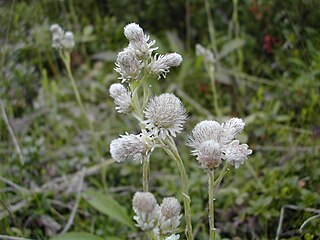
Antennaria alpina is a European and North American species of plant in the sunflower family. Antennaria alpina is native to mountainous and subarctic regions of Scandinavia, Greenland, Alaska, and the Canadian Arctic, extending south at high altitudes in mountains in the Rocky Mountains south to Montana and Wyoming.
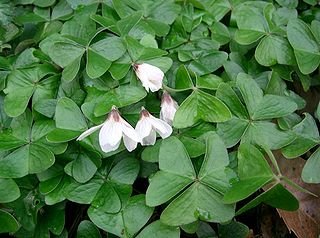
Oxalis or is a large genus of flowering plants in the wood-sorrel family Oxalidaceae, comprising about 570 species. The genus occurs throughout most of the world, except for the polar areas; species diversity is particularly rich in tropical Brazil, Mexico and South Africa.

Arctous alpina, with the common names alpine bearberry, mountain bearberry, or black bearberry is a dwarf shrub in the heather family Ericaceae. The basionym of this species is Arbutus alpina L..
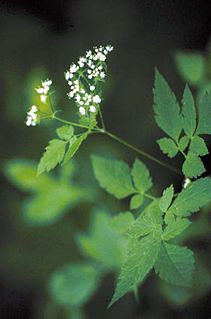
Osmorhiza is a genus of perennial herbs, known generally as sweet cicely, sweetcicely, or sweetroot. Most species are native to North America, but some grow in South America and Asia. Some species are used for medicinal purposes, but have dangerous lookalikes. The fruits of this plant have barbs on the end allowing them to stick to clothing, fur, or feathers.
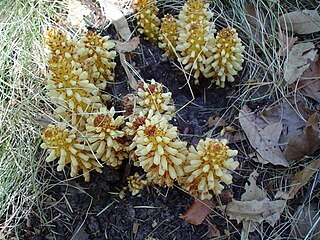
Conopholis is a small genus of flowering plants in the family Orobanchaceae.

Conopholis americana, the American cancer-root, squawroot, bumeh or bear corn, is a perennial, non-photosynthesizing parasitic plant, from the family Orobanchaceae and more recently from the genus Conopholis but also listed as Orobanche, native but not endemic to North America and when blooming, resembles a pine cone or cob of corn growing from the roots of mostly oak and beech trees. It gets its common name for its usage by Native American women to treat menstrual cramps and other female ailments, due to its astringency.

Viola canadensis is more commonly known as Canadian white violet, Canada violet, tall white violet, or white violet. It is widespread across much of Canada and the United States, from Alaska to Newfoundland, south as far as Georgia and Arizona.
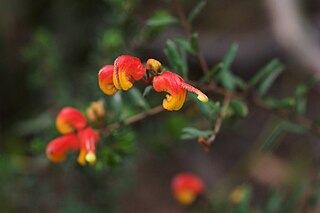
The Australian flowering shrub Grevillea alpina has several common names, including mountain grevillea, alpine grevillea, and cat's claws. It is not limited to alpine environments, and in fact is less common at high elevation than low. The species is variable in appearance, with five general forms described: small-flowered, Grampians, Northern Victorian, Goldfields, and Southern Hills forms. It is found in dry forests and woodlands across Victoria and into southern New South Wales. Some forms of the plant are low to the ground, and some become a spreading shrub. The flowers come in many colours, from white to green to shades of red and pink, or a pattern of several colours. The curled flowers are 1 to 3 centimetres in length. It is attractive to nectar-feeding insects and birds.

Woodsia alpina, commonly known as alpine woodsia, is a fern found in northern latitudes in North America and Eurasia. Also known as northern woodsia or alpine cliff fern, it is typically found in crevices, scree slopes and cliffs containing slate and calcareous rocks, especially limestone.

Abronia alpina is a rare species of flowering plant in the four o'clock family known by the common names Ramshaw Meadows sand verbena and Ramshaw Meadows abronia. It is endemic to Tulare County, California, where it is known from only one area high in the Sierra Nevada.

Chaenactis douglasii is a North American species of flowering plant in the daisy family known by the common name Douglas' dustymaiden.
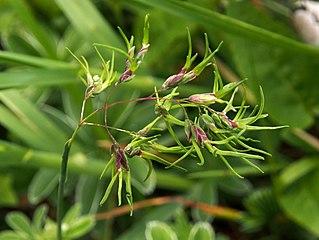
Poa alpina, commonly known as alpine meadow-grass or alpine bluegrass, is a species of grass with a primarily holarctic distribution.

Oenothera macrocarpa, the bigfruit evening primrose, Ozark sundrop or Missouri evening primrose, is a species of flowering plant in the evening primrose family Onagraceae, native to Mexico and the south-central United States, where it is found in calcareous prairies and limestone outcrops.

Miramella alpina, the 'Green Mountain Grasshopper', is a species of 'short-horned grasshoppers' belonging to the family Acrididae subfamily Melanoplinae.

Cirsium eatonii, commonly known as Eaton's thistle or mountaintop thistle, is a North American species of flowering plants in the aster family.
Draba graminea is a species of flowering plant in the mustard family known by the common names Rocky Mountain draba and San Juan Whitlow-grass. It is endemic to the state of Colorado in the United States, where it is limited to the San Juan Mountains.
Townsendia rothrockii is a species of flowering plant in the aster family known by the common name Rothrock's Townsend daisy. It is endemic to Colorado in the United States, where there are 35 occurrences across thirteen counties. Reports of the plant from New Mexico are false.

Astelia alpina called pineapple grass, silver astelia, or perching lily is a commonly found species in alpine and subalpine areas of Tasmania and the Australian Alps. It is a perennial herb that typically dominates its environment by growing in dense clusters, called mats, in alpine bogs. There are two subspecies: Astelia alpina var. novae hollandiae from New South Wales and Victoria and Astelia alpina var. alpina endemic to Tasmania. Both subspecies appear very similar to each other. The species was originally described by Robert Brown.



















